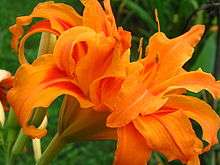Daylily
| Daylily | |
|---|---|
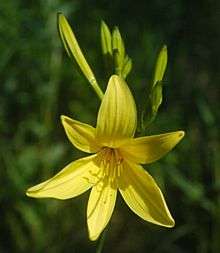 | |
| Hemerocallis lilioasphodelus | |
| Scientific classification | |
| Kingdom: | Plantae |
| Clade: | Angiosperms |
| Clade: | Monocots |
| Order: | Asparagales |
| Family: | Asphodelaceae |
| Subfamily: | Hemerocallidoideae |
| Genus: | Hemerocallis L. |
| Type species | |
| Hemerocallis lilioasphodelus | |
| Synonyms[1] | |
| |
A daylily is a flowering plant in the genus Hemerocallis /ˌhɛmɪroʊˈkælɪs/.[2] Gardening enthusiasts and professional horticulturalists have long bred daylily species for their attractive flowers. Thousands of cultivars have been registered by local and international Hemerocallis societies.[3] Hemerocallis is now placed in family Asphodelaceae, subfamily Hemerocallidoideae, but used to be part of Liliaceae (which includes true lilies).
The name Hemerocallis comes from the Greek words ἡμέρα (hēmera) "day" and καλός (kalos) "beautiful".
Description
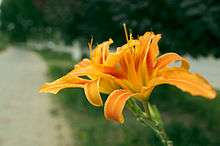
Daylilies are perennial plants, whose name alludes to the flowers which typically last no more than 24 hours (about a day or so). The flowers of most species open in early morning and wither during the following night, possibly replaced by another one on the same scape (flower stalk) the next day. Some species are night-blooming. Daylilies are not commonly used as cut flowers for formal flower arranging, yet they make good cut flowers otherwise as new flowers continue to open on cut stems over several days.
Hemerocallis is native to Asia, primarily eastern Asia, including China, Korea, and Japan. This genus is popular worldwide because of the showy flowers and hardiness of many kinds. There are over 80,000 registered cultivars. Hundreds of cultivars have fragrant flowers, and more scented cultivars are appearing more frequently in northern hybridization programs. Some earlier blooming cultivars rebloom later in the season, particularly if their capsules, in which seeds are developing, are removed.
Most kinds of daylilies occur as clumps, each of which has leaves, a crown, flowers, and roots. The long, linear lanceolate leaves are grouped into opposite fans with arching leaves. The crown is the small white portion between the leaves and the roots. Along the scape of some kinds of daylilies, small leafy "proliferations" form at nodes or in bracts. A proliferation forms roots when planted and is often an exact clone of its parent plant. Many kinds of daylilies have thickened roots in which they store food and water.
A normal, single daylily flower has three petals and three sepals, collectively called tepals, each with a midrib in either the same basic color or a different color. The centermost part of the flower, called the throat, usually is of a different color than the more distal areas of the tepals. Each flower usually has six stamens, each with a two-lobed anther. After successful pollination, a flower forms a botanical capsule (often erroneously called a pod since botanical pods are found in Fabaceae, not Hemerocallis).
The orange or tawny daylily (Hemerocallis fulva), common along roadsides in much of the United States, is native to Asia and regarded as an invasive in North America.[4]
Hemerocallis species are toxic to cats and ingestion may be fatal. Treatment is usually successful if started before renal failure has developed.[5]
Taxonomy
Species
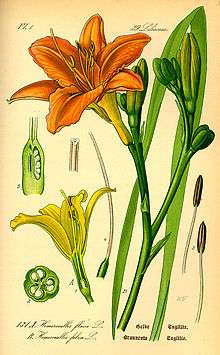
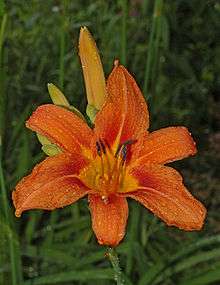

The World Checklist of Selected Plant Families recognizes 19 species as of September 2014:[1]
- Hemerocallis citrina Baroni (syn. H. altissima Stout, H. coreana Nakai) - China, Japan, Korea, Russian Far East
- Hemerocallis coreana Nakai - Japan, Korea, Shandong Province in China
- Hemerocallis darrowiana S.Y.Hu - Sakhalin Island in Russia
- Hemerocallis dumortieri E.Morren - China, Japan, Korea
- Hemerocallis esculenta Koidz. (syn. H. pedicellata Nakai) >) - China, Japan, Russian Far East
- Hemerocallis forrestii Diels - Sichuan + Yunnan Provinces in China
- Hemerocallis fulva (L.) L. (H. sempervirens Araki, H. sendaica Ohwi and H. aurantiaca Baker are now treated as varieties of this species) – orange daylily, tawny daylily, tiger lily, ditch lily - China, Japan, Korea; naturalized in Europe, North America, New Zealand, Indian Subcontinent; considered an invasive weed in some places
- Hemerocallis hakuunensis Nakai (syn. H. micrantha Nakai) - Korea
- Hemerocallis hongdoensis M.G.Chung & S.S.Kang - Hongdo Islands of South Korea
- Hemerocallis lilioasphodelus L. (syn. H. flava (L.) L.) – lemon lily, yellow daylily - China, Mongolia, Russian Far East, Siberia, Kazakhstan; naturalized in Europe and North America
- Hemerocallis littorea Makino - Korea, Japan
- Hemerocallis middendorffii Trautv. & C.A.Mey. (includes H. exaltata Stout as H. m. var. exaltata) - China, Japan, Korea, Russian Far East
- Hemerocallis minor Mill. (syn. H. sulphurea Nakai) - China, Mongolia, Korea, Russian Far East, Siberia
- Hemerocallis multiflora Stout - Henan Province in China
- Hemerocallis nana W.W.Sm. & Forrest - Yunnan Province in China
- Hemerocallis plicata Stapf - Sichuan + Yunnan Provinces in China
- Hemerocallis taeanensis S.S.Kang & M.G.Chung - Korea
- Hemerocallis thunbergii Barr (syn. H. serotina Focke, H. vespertina Hara) - Japan
- Hemerocallis yezoensis H.Hara - Japan, Kuril Islands
Two hybrids are recognized:[1]
- Hemerocallis × exilis Satake = H. fulva var. angustifolia × H. thunbergii
- Hemerocallis × fallaxlittoralis Konta & S.Matsumoto = H. littorea × H. thunbergii
A number of hybrid names appear in the horticultural literature but are not recognized as valid by the World Checklist of Selected Plant Families. These include:[1]
- H. × hybrida
- H. × ochroleuca
- H. × stoutiana
- H. × traubara, H. × traubiana
- H. × washingtonia
- H. × yeldara, H. × yeldiana
Cultivation
The daylily is often called "the perfect perennial", due to its brilliant colors, ability to tolerate drought and frost and to thrive in many different climate zones, and generally low maintenance. It is a vigorous perennial that lasts for many years in a garden, with very little care and adapts to many different soil and light conditions.[6] Daylilies have a relatively short blooming period, depending on the type. Some will bloom in early spring while others wait until the summer or even autumn. Most daylily plants bloom for 1 through 5 weeks, although some bloom twice in one season ("rebloomers)".[7]
The Orange Daylily (Hemerocallis fulva), and the sweet-scented Lemon-lily (H. lilioasphodelus; H. flava, old name) were early imports from England to 17th-century American gardens and soon escaped from gardens. The introduced Orange Daylily, although not a true lily, is now common in many natural areas, where it is considered an invasive. Hemerocallis lilioasphodelus gained the Royal Horticultural Society's Award of Garden Merit.[8]
Cultivars
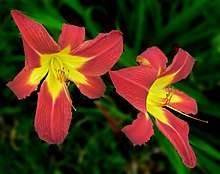

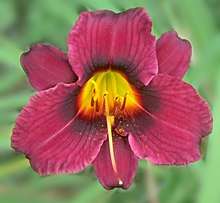
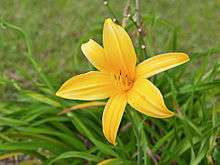
There are more than 80,000 daylily cultivars.[6] Depending on the species and cultivar, daylilies grow in USDA plant hardiness zones 1 through 11, making them some of the more adaptable landscape plants. Hybridizers have developed the vast majority of cultivars within the last 100 years. The large-flowered, bright yellow Hemerocallis 'Hyperion', introduced in the 1920s, heralded a return to gardens of the once-dismissed daylily, and is still widely available in the nursery trade. Daylily breeding has been a specialty in the United States, where daylily heat- and drought-resistance made them garden standbys since the 1950s. New cultivars have sold for thousands of dollars, but many sturdy and prolific cultivars sell at reasonable prices of US$20 or less.
Hemerocallis is one of the very highly hybridized plant genera. Hybridizers register hundreds of new cultivars yearly. Hybridizers have extended the genus' color range from the yellow, orange, and pale pink of the species, through vibrant reds, purples, lavenders, greenish tones, near-black, near-white, and more. However, hybridizers have not yet been able to produce a daylily with primarily blue flowers in forms of blue such as azure blue, cobalt blue, and sky blue. Flowers of some cultivars have small areas of cobalt blue.
Other flower traits that hybridizers developed include height, scent, ruffled edges, contrasting "eyes" in the center of a bloom, and an illusion of glitter which is called "diamond dust." Sought-after improvements include foliage color and variegation and plant disease resistance and the ability to form large, neat clumps. Hybridizers also seek to make less-hardy plants hardier in Canada and the Northern United States by crossing evergreen and semi-evergreen plants with those that become dormant and by using other methods. Many kinds of daylilies form clumps of crowded shoots. It is possible to dig up every 3 or so years, separate shoots, and replant only some of the shoots to reduce crowding. This process increases the flowering of many cultivars.
In the last several decades, many hybridizers have focused on breeding tetraploid plants, which tend to have sturdier scapes and tepals than diploids and some flower-color traits that are not found in diploids. Until this trend took root, nearly all daylilies were diploid. "Tets," as they are called by aficionados, have 44 chromosomes, while triploids have 33 chromosomes and diploids have 22 chromosomes per individual plant.[9] Hemerocallis fulva 'Europa', H. fulva 'Kwanso', H. fulva 'Kwanso Variegata', H. fulva 'Kwanso Kaempfer', H. fulva var. maculata, H. fulva var. angustifolia, and H. fulva 'Flore Pleno' are all triplods that almost never produce seeds and reproduce almost solely by underground runners (stolons) and dividing groups by gardeners. A polymerous daylily flower is one with more than three sepals and more than three petals. Although some people synonymize "polymerous" with "double," some polymerous flowers have over five times the normal number of petals.
Formerly daylilies were only available in yellow, pink, fulvous (bronzed), and rosy-fulvous colors, now they come in an assortment of many more color shades and tints thanks to intensive hybridization. They can now be found in nearly every color except pure blue and pure white. Those with yellow, pink, and other pastel flowers may require full sun to bring out all of their colors; darker varieties, including many of those with red and purple flowers are not colorfast in bright sun.
Awards
The highest award a cultivar can receive in the United States is the Stout Silver Medal, given in memory of Dr. Arlow Burdette Stout, who is considered to be the father of modern daylily breeding in North America. This annual award—as voted by American Hemerocallis Society Garden judges—can be given only to a cultivar that has first received the Award of Merit not less than two years previously. The 2014 winner of the Stout Silver Medal is 'Webster's Pink Wonder', hybridized by Richard Webster and introduced by R. Cobb. A complete list of Stout Silver Medal winners can be seen on the AHS website.[10]
In the UK the following cultivars have gained the Royal Horticultural Society's Award of Garden Merit:-[11]
- 'All American Chief'
- 'Always Afternoon'
- 'Arctic Snow'
- 'Asterisk'
- 'August Frost'
- 'Beauty to Behold'
- 'Burning Daylight'[12]
- 'Cat Dancer'
- 'Cayenne'
- 'Cherry Eyed Pumpkin'
- H. citrina
- 'Condilla'
- 'Curly Cinnamon Windmill'
- 'Custard Candy'
- 'Eggplant Escapade'
- 'Elegant Candy'
- 'Fooled Me'
- 'Grey Witch'
- 'Holly Dancer'
- 'Jamaican Me Crazy'
- 'Jellyfish Jealousy'
- 'Julie Newmar'
- 'Karen's Curls'
- 'Killer'
- 'Lady Neva'
- 'Lime Frost'
- 'Mahogany Magic'
- 'Mary's Gold'
- 'Moonlit Masquerade'
- 'North Wind Dancer'
- 'Old Tangiers'
- 'Performance Anxiety'
- ‘Pink Damask’[13]
- 'Primal Scream'
- 'Radiant Moonbeam'
- ’Red Precious’[14]
- 'Ruby Spider'[15]
- 'Running Late'
- 'Russian Rhapsody'
- 'Selma Longlegs'
- 'Serena Sunburst'[16]
- 'Sir Modred'[17]
- 'Spider Man'
- 'Stafford'[18]
- 'Strawberry Candy'
- 'Tuxedo Junction'
Uses
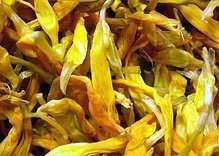
The flowers of Hemerocallis citrina are edible and are used in Chinese cuisine.[19] They are sold (fresh or dried) in Asian markets as gum jum (金针 in Chinese; pinyin: jīn zhēn) or yellow flower vegetables (黃花菜 in Chinese; pinyin: huáng huā cài). They are used in hot and sour soup, daylily soup (金針花湯), Buddha's delight, and moo shu pork.
See also
- Arlow Stout – pioneer in the hybridization of daylilies
- Contarinia quinquenotata – daylily gall midge
- Siloam daylilies – over 450 daylily cultivars registered by Pauline Henry.
References
- 1 2 3 4 World Checklist of Selected Plant Families, The Board of Trustees of the Royal Botanic Gardens, Kew, retrieved July 19, 2014
- ↑ Sunset Western Garden Book, 1995:606–607
- ↑ "International Daylily Groups". American Hemerocallis Society.
- ↑ "Weeds of Wisconsin" U.S. Department of Agriculture. retrieved 10-26-09.
- ↑ Fitzgerald, K.T. (2010). "Lily toxicity in the cat". Topics in Companion Animal Medicine. 25 (4): 213–217. doi:10.1053/j.tcam.2010.09.006. PMID 21147474.
- 1 2 "Growing daylilies".
- ↑ "Dayliles Frequently Asked Questions". American Hemerocallis Society. American Hemerocallis Society, Inc. Retrieved 12 June 2012.
- ↑ "Hemerocallis lilioasphodelus".
- ↑ Daylilies undated info page at University of Nebraska. Accessed August 1, 2007.
- ↑ "AHS Awards and Honors: Stout Medal Winners".
- ↑ "AGM Plants - Ornamental" (PDF). Royal Horticultural Society. July 2017. p. 47. Retrieved 3 March 2018.
- ↑ "RHS Plantfinder - Hemerocallis 'Burning Daylight'". Retrieved 2 March 2018.
- ↑ "RHS Plantfinder - Hemerocallis 'Pink Damask'". Retrieved 2 March 2018.
- ↑ "RHS Plantfinder - Hemerocallis 'Red Precious'". Retrieved 2 March 2018.
- ↑ "RHS Plantfinder - Hemerocallis 'Ruby Spider'". Retrieved 2 March 2018.
- ↑ "RHS Plantfinder - Hemerocallis 'Serena Sunburst'". Retrieved 2 March 2018.
- ↑ "RHS Plantfinder - Hemerocallis 'Sir Modred'". Retrieved 2 March 2018.
- ↑ "RHS Plantfinder - Hemerocallis 'Stafford'". Retrieved 2 March 2018.
- ↑ Hemerocallis citrina
External links
| Look up daylily in Wiktionary, the free dictionary. |
| Wikimedia Commons has media related to Hemerocallis. |
| Wikispecies has information related to Hemerocallis |
| Wikibooks has a book on the topic of: How to Grow Daylilies |
- "Hemerocallis". The Plant List. Missouri Botanical Garden. Royal Botanic Gardens, Kew.
- "Hemerocallis". Tropicos. Missouri Botanical Garden.
- Hemerocallis species by the Drs. Lobeck has species, hybrids, and cultivars; links; terms and Latin meanings; images and history of hybrids
- DaylilyDB Daylily Database — Largest online collection of community submitted daylily photos, searchable by cultivar, hybridizer, color, and registration year, providing data and photos.
- Charlotte's Daylily Diary Charlotte Chamitoff's Daylily Diary is a wealth of information on growing daylilies and daylily hybridizing. The website is full of daylily images and information about individual hybridizers.
- Charlotte's International Garden of the Week For 9 years, Charlotte Chamitoff has delighted daylily lovers with her Garden of the Week. See daylily gardens from all over the world.
